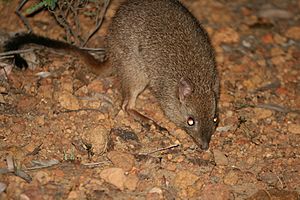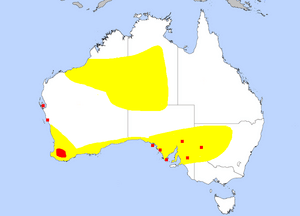Woylie facts for kids
Quick facts for kids Woylie |
|
|---|---|
 |
|
| Conservation status | |
| Scientific classification | |
| Subspecies | |
|
|
 |
|
| Historic woylie range in yellow, current range in red |
The woylie (Bettongia penicillata), also known as the brush-tailed bettong, is a very rare, small marsupial. It is found only in Australia. There are two types, or subspecies. One is B. p. ogilbyi, which is still alive. The other, B. p. penicillata, is now extinct.
Contents
What is a Woylie?
The woylie is a type of potoroo marsupial. It digs for fungi at night and usually lives alone. It builds a nest in the middle of its home area.
How Big Are They?
Woylies are about 31 to 38 centimeters long from head to body. Their fur is grey-brown on their back, buff (a pale yellowish-brown) on their face and sides, and light cream underneath. They have silvery hairs mixed in with their grey-brown fur.
Their tail is almost as long as their body, about 29 to 35 centimeters. It is reddish-brown and has a black tip. The top of their tail has a ridge of longer fur. Woylies weigh about 1.3 kilograms.
How Do They Look Different from Other Animals?
Woylies look a bit like the boodie (Bettongia lesueur). But woylies are lighter on their belly and their tail is not as dark as the boodie's. Woylies have pale rings around their eyes. Their nose is also longer and more pointed than the boodie's.
Where Do Woylies Live?
In the mid-1800s, woylies were very common. They lived across about 60% of mainland Australia. This included most of South Australia, parts of Victoria, and central New South Wales.
Where They Live Now
By the 1920s, woylies had disappeared from most of their original homes. As of 1992[update], they were only found in four small areas in Western Australia. Thanks to special programs, some populations have been brought back to South Australia. As of 1996[update], they lived in six places in Western Australia and on three islands and two mainland spots in South Australia.
One important place for woylies is the Dryandra Woodland in Western Australia. Efforts to control red foxes helped, but then feral cats became a problem. Now, programs to control feral cats are helping woylie numbers grow again.
Their Home Environment
Today, woylies mostly live in open sclerophyll forests. These forests have eucalypt trees and a thick layer of tussock grasses underneath. However, woylies used to live in many different places. This included dry scrublands and spinifex grasslands in the desert.
What Do Woylies Eat?
Woylies mostly eat fungi that grow underground. They dig these up with their strong front claws. They might also eat tubers, seeds, insects, and tree sap.
How They Digest Food
Woylies can't digest fungi directly. Instead, bacteria in their stomach break down the fungi. These bacteria then produce nutrients that the woylie's body can use. When woylies were common, they helped spread fungal spores around desert areas.
Seasonal Diet
In summer and autumn, woylies eat many types of underground fungi. A type of truffle-like fungus called Mesophellia is a big part of their diet then. Woylies eat the soft inside of these truffles, leaving the hard outer layer. This food gives them fats and important minerals. In other seasons, woylies might eat more plants along with fungi.
Woylies have also been seen eating large seeds from Australian sandalwood trees (Santalum spicatum). They sometimes bury these seeds to eat later. This habit likely helped spread the sandalwood trees.
Woylie Behaviour
Woylies are mostly nocturnal, meaning they are active at night. They rest during the day and come out around dusk. They always return to their nest before the sun comes up.
Reproduction and Life Cycle
Woylies can have babies all year if conditions are good. Females can start having babies when they are six months old. They can give birth every 3.5 months. In the wild, woylies usually live for about four to six years.

Building a Nest
A woylie builds a dome-shaped nest in a shallow dip under a bush. They can curl their tail to carry grass, shredded bark, sticks, and leaves to their nest. Their nests are well-made and hidden.
How They Move
If a woylie is disturbed at its nest, it quickly leaves with a loud noise. It hops away with its back arched, head low, and tail stretched out. They use a two-legged hopping motion to escape predators.
Their Home Range
Each woylie uses a large area for finding food. Males usually have bigger areas than females. These areas often overlap with other woylies' areas. But each woylie defends a smaller central territory around its main nest. This smaller area only overlaps between males and females.
Why Woylie Numbers Dropped
Woylies were once very common across southern Australia. Early European settlers in Western Australia knew them well. People even used to eat woylies in the early days, and some kept them as pets.
The Decline
By the 1930s, woylie numbers suddenly dropped in many areas. Some lasted until the 1950s. This decline was likely caused by several things:
- Introduced animals: Animals like grazing animals brought by settlers ate their food.
- Land clearing: Forests were cut down for farms and pastures.
- Predators: Red foxes and feral cats, which came with Europeans, hunted woylies.
- Rabbits: European rabbits might have competed for food or damaged their habitat.
- Fire: Changes in how fires happened in the bush might have also played a part.
By the 1970s, woylies were highly endangered.
Saving the Woylie
In the late 1900s, people started working to save woylies. They brought woylies back to places where they used to live, after controlling red foxes. Stable groups were set up in places like Venus Bay and St Peter Island in South Australia. They also went to Shark Bay in Western Australia and Scotia Sanctuary in New South Wales.
Because of these efforts, the woylie population grew. In 1996, they were even taken off the threatened species list. By 2001, there were about 40,000 woylies.
A New Decline
However, woylie numbers suddenly dropped again in late 2001. In just five years, the population fell to only 10-30% of what it was. The woylie was put back on the IUCN Red List as critically endangered. Scientists think diseases, predators, and habitat loss all contributed to this drop. In 2011, there were fewer than 5,600 woylies left.
Current Conservation Efforts
Despite these problems, woylies still live in small groups in safe, predator-free areas. For example, a group was started in 2010 at Wadderin Sanctuary in Western Australia. Programs to control predators, especially feral cats, are helping woylie numbers recover in places like Perup and Dryandra Woodland.
Woylies have also been successfully moved to a large fenced area at Mount Gibson Sanctuary in Western Australia. There are plans to bring them back to Dirk Hartog Island after all feral cats and livestock are removed. They are also planned for reintroduction to fenced areas at Newhaven in the Northern Territory, and Mallee Cliffs National Park and the Pilliga Forest in New South Wales.
The woylie will be an important animal in the Great Southern Ark project in South Australia. This project will use large fences and baiting programs to control feral cats and foxes, helping woylies return to the area.
- Australian Wildlife Conservancy woylie fact sheet


